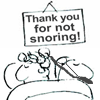I was wondering if someone was able to help me better understand why I've been getting lower AHI numbers using the CPAP setting on my S8 VPAP Auto. For over a year I have been on Auto VPAP mode, but was having trouble getting by AHI number below 13. (VPAP settings of 20/12.) After just about giving up, I decided to try the CPAP mode (with the setting of 18.) Surprisingly, I was able to handle the pressure and had an AHI of 5.6 the first night. (I'm having a little trouble at this pressure keeping the leaks under control, but so far they've been at manageable levels.) Still tweaking the pressure for a better AHI reading, but I'm wondering why CPAP is providing better results. I was not diagnosed with central apnea, just OSA.
I guess I always thought of Auto xPAP as some kind of magic, smart therapy that would adjust to your needs and provide the best results. But now in my case, CPAP is working better. I'm wondering why?
CPAP vs Auto VPAP
CPAP vs Auto VPAP
_________________
| Machine: AirCurve™ 10 VAuto BiLevel Machine with HumidAir™ Heated Humidifier |
| Mask: ResMed AirTouch™ F20 Mask with Headgear + 2 Replacement Cushions Bundle |
| Additional Comments: 100% compliant since 2006. ResMed AirCurve 10 VAuto with Airtouch F20 mask. |
Re: CPAP vs Auto VPAP
The theory of automatic pressure adjustment has it that the automatic machines see enough apnea and hypopnea precursors in your breathing to let them preempt those breathing interruptions.
But the fact is that their preemption is far from perfect -- so obstructive events sneak in before the pressure rises, and the pressure responds after the fact. Furthermore, the algorithms don't learn from experience they don't have a "don't go down there" flag and a result, once your breathing is settled, the machine will always drop you back down to where you ran into trouble in the first place, in the hope of letting you enjoy lower pressure, and preempting events again should the need arise.
This is true of all automatic algorithms.
Furthermore, all automatic algorithms have to find a way of refraining from raising pressure when the breathing interruption is not caused by obstructions. They go about it differently -- none are perfect -- and this too may mean you'll get a higher AHI on autos.
jnk, did you know your present tag line about theory and practice was also attributed to a Jan L. A. van de Snepscheut? His present Wikipedia entry look like a joke.... but the statement, one of my favorites for many years, is profoundly true, no matter who said it: In theory, there is no difference between theory and practice. In practice, there is.
And that's why APAP's are great in theory, but sometime CPAP's give better therapy.
But the fact is that their preemption is far from perfect -- so obstructive events sneak in before the pressure rises, and the pressure responds after the fact. Furthermore, the algorithms don't learn from experience they don't have a "don't go down there" flag and a result, once your breathing is settled, the machine will always drop you back down to where you ran into trouble in the first place, in the hope of letting you enjoy lower pressure, and preempting events again should the need arise.
This is true of all automatic algorithms.
Furthermore, all automatic algorithms have to find a way of refraining from raising pressure when the breathing interruption is not caused by obstructions. They go about it differently -- none are perfect -- and this too may mean you'll get a higher AHI on autos.
jnk, did you know your present tag line about theory and practice was also attributed to a Jan L. A. van de Snepscheut? His present Wikipedia entry look like a joke.... but the statement, one of my favorites for many years, is profoundly true, no matter who said it: In theory, there is no difference between theory and practice. In practice, there is.
And that's why APAP's are great in theory, but sometime CPAP's give better therapy.
_________________
| Mask: AirFit™ P10 Nasal Pillow CPAP Mask with Headgear |
| Additional Comments: Machine: Resmed AirSense10 for Her with Climateline heated hose ; alternating masks. |
And now here is my secret, a very simple secret; it is only with the heart that one can see rightly, what is essential is invisible to the eye.
Antoine de Saint-Exupery
Good advice is compromised by missing data
Forum member Dog Slobber Nov. 2023
Antoine de Saint-Exupery
Good advice is compromised by missing data
Forum member Dog Slobber Nov. 2023
-
jonecoogan
- Posts: 3
- Joined: Thu Jan 21, 2010 8:55 am
CPAP vs Auto VPAP
Yes, bi-levels are extremely expensive. Fortunately, I've been blessed w/pretty good insurance.However,I was able to pick up a lightly used Respironics pre-M Series Bi-PAP Auto w/Bi-Flex our of pocket at a cpap auction site,complete,wireless than 300 actual hours on it for $500 plus shipping, to use as a backup device should anything happen to my VPAP Auto.I did have to provide a copy of my bi-level prescription to bid on it and buy it.
- JohnBFisher
- Posts: 3821
- Joined: Wed Oct 14, 2009 6:33 am
Re: CPAP vs Auto VPAP
As I understand it, the Auto algorithm does not try to adjust for hypopneas, rather just the apneas. So, if your AHI number consists mostly of HI (hypopneas) and less of the AI (apenas), then it's possible the CPAP would work better for you. As you note, you can reduce the pressure until your apneas crawl back up.BigEd wrote:... I was wondering if someone was able to help me better understand why I've been getting lower AHI numbers using the CPAP setting on my S8 VPAP Auto. For over a year I have been on Auto VPAP mode, but was having trouble getting by AHI number below 13. (VPAP settings of 20/12.) After just about giving up, I decided to try the CPAP mode (with the setting of 18.) Surprisingly, I was able to handle the pressure and had an AHI of 5.6 the first night. ...
Or perhaps with the Auto mode your mask was in fact too loose when the pressure ramped up to handle the apneas.
By the way, I find that with the higher pressure (my ASV unit will ramp my inhalation pressure upto the 23cm H2O range), I need both a full face mask. And I also need to tighten the headgear more than I would at lower pressure.
Anyway, it's just my 2 cents worth.
_________________
| Mask: Quattro™ FX Full Face CPAP Mask with Headgear |
| Additional Comments: User of xPAP therapy for over 20 yrs. Resmed & Respironics ASV units with EEP=9cm-14cm H2O; PSmin=4cm H2O; PSmax=15cm H2O; Max=25cm H2O |
"I get up. I walk. I fall down. Meanwhile, I keep dancing” from Rabbi Hillel
"I wish to paint in such a manner as if I were photographing dreams." from Zdzisław Beksiński
"I wish to paint in such a manner as if I were photographing dreams." from Zdzisław Beksiński
Re: CPAP vs Auto VPAP
It's only the ResMed auto that does not try to respond to hypopneas at all, and stops responding to apneas once the pressure is 10. ResMed above 10 cm h2o is driven solely by snores and flow limitations.JohnBFisher wrote:As I understand it, the Auto algorithm does not try to adjust for hypopneas, rather just the apneas. So, if your AHI number consists mostly of HI (hypopneas) and less of the AI (apenas), then it's possible the CPAP would work better for you. As you note, you can reduce the pressure until your apneas crawl back up.BigEd wrote:... I was wondering if someone was able to help me better understand why I've been getting lower AHI numbers using the CPAP setting on my S8 VPAP Auto. For over a year I have been on Auto VPAP mode, but was having trouble getting by AHI number below 13. (VPAP settings of 20/12.) After just about giving up, I decided to try the CPAP mode (with the setting of 18.) Surprisingly, I was able to handle the pressure and had an AHI of 5.6 the first night. ...
The DeVilbiss algorithm, for example is driven by snores, apneas and hypopneas, and and treats apneas and hypopneas s just the same. It ignores (does not recognize) flow limitations.
Respironics uses info about flow limitations, responds differently to hypopneas and apneas, and will respond to them at any pressure; when 3 pressure raises don't help, the Respironics algorithm figures it goofed, and backs the pressure down.
Sandman (Puritan Bennett) responds to apneas, snores, flow limitations (if they're in a run) and hypopneas, and has a different response if the hypopnea is accompanied by a flow limitation and if it isn't.
O.
_________________
| Mask: AirFit™ P10 Nasal Pillow CPAP Mask with Headgear |
| Additional Comments: Machine: Resmed AirSense10 for Her with Climateline heated hose ; alternating masks. |
And now here is my secret, a very simple secret; it is only with the heart that one can see rightly, what is essential is invisible to the eye.
Antoine de Saint-Exupery
Good advice is compromised by missing data
Forum member Dog Slobber Nov. 2023
Antoine de Saint-Exupery
Good advice is compromised by missing data
Forum member Dog Slobber Nov. 2023
- JohnBFisher
- Posts: 3821
- Joined: Wed Oct 14, 2009 6:33 am
Re: CPAP vs Auto VPAP
Great stuff. Thanks for taking the time to post the differences in the approaches!ozij wrote:... It's only the ResMed auto that does not try to respond to hypopneas at all ...
_________________
| Mask: Quattro™ FX Full Face CPAP Mask with Headgear |
| Additional Comments: User of xPAP therapy for over 20 yrs. Resmed & Respironics ASV units with EEP=9cm-14cm H2O; PSmin=4cm H2O; PSmax=15cm H2O; Max=25cm H2O |
"I get up. I walk. I fall down. Meanwhile, I keep dancing” from Rabbi Hillel
"I wish to paint in such a manner as if I were photographing dreams." from Zdzisław Beksiński
"I wish to paint in such a manner as if I were photographing dreams." from Zdzisław Beksiński
-
azhosehead
- Posts: 16
- Joined: Mon Jan 04, 2010 7:46 am
Re: CPAP vs Auto VPAP
There seems to be two schools of thought on the "auto" titration therapy: some respiratory therapists think the machine eliminates the need for a sleep study the machine does it all. The doctors I have encountered don't like it for the reasons that ozij points out. In fact, last round of sleep studies I had done "best practices" don't recommend bi-level titration at all unless the patient has breathing problems or CPAP pressures start running 16 and above.
That said, maybe the auto machines are helpful to people with milder cases of OSA but I wouldn't trust it without a sleep study to confirm to what degree you experience OSA.
That said, maybe the auto machines are helpful to people with milder cases of OSA but I wouldn't trust it without a sleep study to confirm to what degree you experience OSA.
Re: CPAP vs Auto VPAP
Thanks to all for the info. I now have a better understanding of how the auto works versus the straight CPAP. Looks like I won't be able to open my own sleep clinic with the equipment I have. Thanks again for the responses.
_________________
| Machine: AirCurve™ 10 VAuto BiLevel Machine with HumidAir™ Heated Humidifier |
| Mask: ResMed AirTouch™ F20 Mask with Headgear + 2 Replacement Cushions Bundle |
| Additional Comments: 100% compliant since 2006. ResMed AirCurve 10 VAuto with Airtouch F20 mask. |










